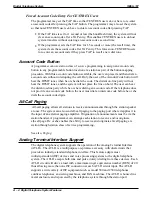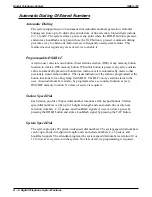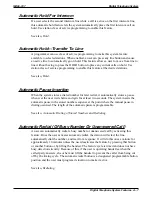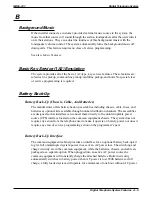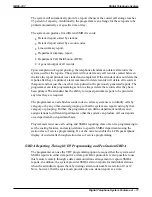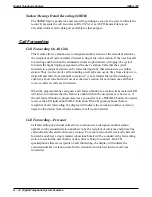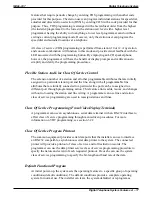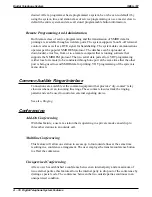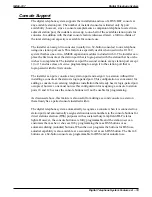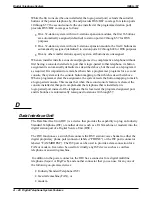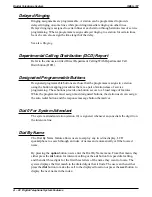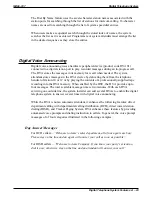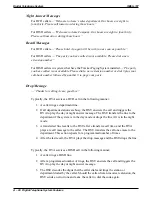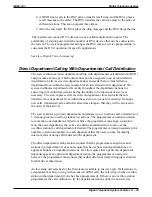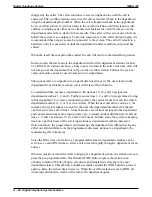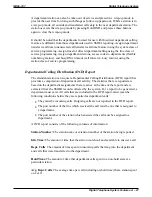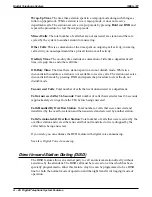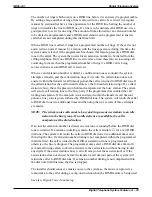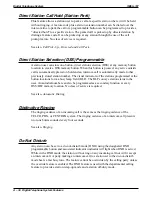
Unanswered Call Transfer Recall Timing
A transferred call that is unanswered after a pre-programmed length of time will return to
the station that transferred it. The system will return the call to both attendant stations
when the tandem attendant feature is enabled. When LCD speakerphones are employed,
the display will show the station number or name as well as the line number that is being
re-called. The system class of service programming determines the recall time for an
unanswered call transfer.
Unscreened Call Transfer
A user can transfer a call to another station without first announcing it. The transferred
call will camp-on to the other station where it will ring and await an answer. The call will
automatically ring back to the transferring station after a programmable recall period.
There is no limit as to how many calls users can camp-on to another station. A
transferred call will only ring if the station is idle. If the station is busy, the call will wait
until it is idle before it rings. The programmer can use the system class of service
programming to set the recall time for an unanswered transferred call.
Call Waiting Tone
A telephone user can signal a busy station with the call waiting tone to indicate that he or
she wishes to contact them. Users dial a special code to activate the call waiting tone.
Caller ID
The central office sends Caller ID data along lines assigned to the Caller ID service.
Caller ID information is displayed at a system LCD speakerphone only if the
programmer assigns that telephone to the Caller ID service, and then only for those
Caller ID lines that are assigned to that station and arranged to perform as follows:
•
ring audibly
•
can be answered by user pressing button for the ringing line
•
are transferred to the station.
The station receives Caller ID data between the first and second rings. A programmer can
enable the first ring for a line assigned to Caller ID to be either audible or silent.
Selecting the “silent” option ensures that the Caller ID data is displayed prior to ringing,
nearly eliminating the loss of Caller ID data.
Station users may automatically retrieve and dial the last Caller ID number displayed at a
station by using a preprogrammed SAVE recovery button. Because the programmer can
store the local area code and up to 100 6-digit area code and local office codes, ten-digit
Caller ID numbers can automatically be transformed into a format that can be dialed.
IMI66–107
Digital Telephone System
Digital Telephone System Features A – 15
Summary of Contents for Air Impact DSU
Page 2: ...Printed in U S A GCA47 157 ...
Page 30: ......
Page 112: ......
Page 192: ...Digital Telephone System IMI66 107 3 80 System Programming ...
Page 283: ......
Page 284: ......
Page 285: ......
Page 286: ......
Page 287: ......
Page 288: ......
Page 289: ......
Page 290: ......
Page 291: ......
Page 292: ......
Page 293: ......
Page 294: ......
Page 295: ......
Page 296: ......
Page 297: ......
Page 298: ......
Page 299: ......
Page 300: ......
Page 301: ......
Page 302: ......
Page 303: ......
Page 304: ......
Page 305: ......
Page 306: ......
Page 307: ......
Page 308: ......
Page 309: ......
Page 310: ......
Page 311: ......
Page 312: ......
Page 313: ......
Page 314: ......
Page 315: ......
Page 316: ......
Page 317: ......
Page 318: ......
Page 319: ......
Page 320: ......
Page 321: ......
Page 322: ......
Page 323: ......
Page 324: ......
Page 325: ......
Page 326: ......
Page 327: ......
Page 328: ......
Page 329: ......
Page 330: ......
Page 331: ......
Page 332: ......
Page 333: ......
Page 334: ......
Page 335: ......
Page 336: ......
Page 337: ......
Page 338: ......
Page 339: ......
Page 340: ......
Page 431: ......
Page 436: ......
Page 437: ......
Page 438: ......




